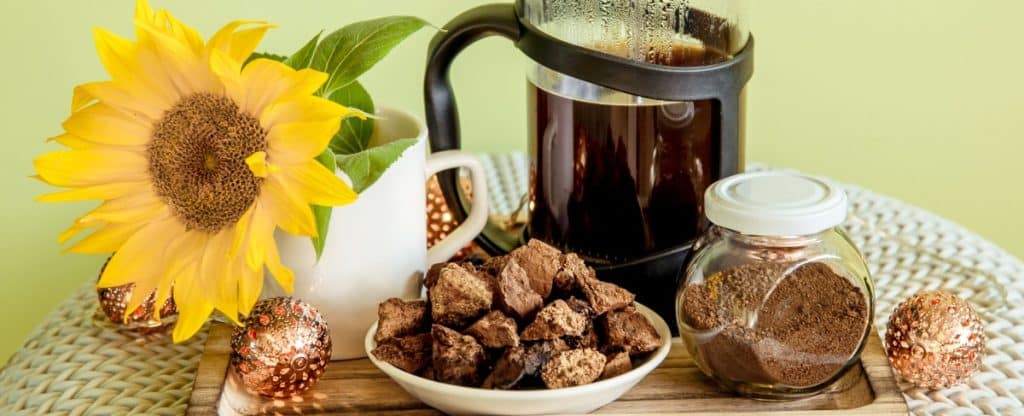Gourmet and medicinal mushrooms are enjoying a surge in popularity, and to meet the demand, producers are releasing new and innovative mushroom products at a rapid rate.
Mushroom powders are one of these products, and a quick search in-store or online will reveal a large selection.
In fact, there are currently so many mushroom powders on the market, both culinary and medicinal, that it can be a little confusing. But we are here to help.
Read on to learn more about different kinds of mushroom powder, what to look for when buying mushroom powder and how to use mushroom powder in your daily routine.
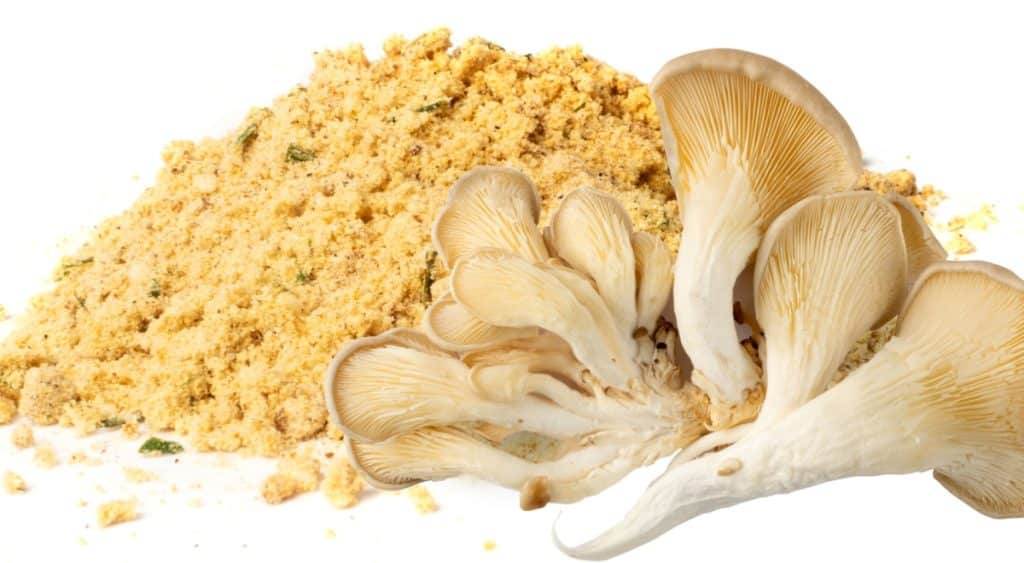
What is Mushroom Powder?
Traditionally, mushroom powder consisted of whole dried mushrooms finely ground to make a powder.
Although this form of mushroom powder is still sought-after for culinary applications, another, more potent form of mushroom powder is available that’s made using mushroom extracts.
You’ll also come across mushroom powder made from myceliated grain, which is mushroom mycelium grown on a grain substrate. The fully colonized grain is then dried and ground into powder.
This type of mushroom powder contains lots of grain, meaning you get less beneficial mushroom compounds per gram.
People generally group mushroom powders into two broad categories: culinary or medicinal.
But it’s not always that straightforward, as edible mushrooms are nutrient-dense functional foods, and many delicious gourmet mushrooms also offer significant health benefits.
Mushroom powders may contain only one type of mushroom or combine several different species to form a specific culinary or medicinal blend.
Culinary Mushroom Powder
Some of the most popular culinary mushroom powders are those made with porcini and shiitake mushrooms, as these mushrooms have an intense umami taste.
Umami, often referred to as the fifth primary taste, occurs naturally in foods with high levels of glutamate, including mushrooms, seaweed, tomatoes and cheese.
When you eat these foods, the glutamates bind to the receptors on your taste buds, providing a savory, brothy taste and enhancing all other flavors, including salty, sweet, sour and bitter.
Porcini and shiitake mushrooms have a higher glutamate content than many other mushrooms, giving them a more pronounced savory, meaty flavor.
Drying mushrooms intensifies their flavors and can break down proteins, creating more glutamate. Thus, dried porcini and shiitake mushrooms tend to have more potent umami flavors.
But they are not the only mushrooms that people dry and powder for culinary use. You’ll also find several other gourmet mushroom powders, including chanterelle, maitake, lion’s mane, morel, chicken of the woods and oyster mushroom powders.
And there are numerous blends that combine two or more different mushroom powders to provide a broader range of benefits and flavors.
It’s easy to make your own culinary mushroom powder at home. All you need is a blender or coffee grinder and your choice of dried mushrooms.
Adding mushroom powder to dishes adds rich, earthy flavors, enhances the taste of other ingredients and benefits your health.
But, if your primary reason for buying mushroom powder is specific medicinal benefits, we recommend using a measured dose of medicinal mushroom extract powder.

Medicinal Mushroom Powder
Several of the most potent medicinal mushrooms are not suitable to eat. So the best way to consume them is in tea or as a tincture, loose powder or capsule.
The best medicinal mushroom powders are those made using mushroom extracts, as they provide more benefits.
In the section below, we go into the difference between powdered mushrooms and mushroom extract powder in more detail.
When buying medicinal mushroom powder, check the ingredients carefully to ensure you’re getting a quality product that will provide the benefits you’re after.
Here are some of the medicinal mushrooms commonly used to make mushroom extract powders:
Like culinary mushroom powder, medicinal mushroom powders can contain one type of mushroom or a blend of several medicinal mushrooms.
Which powder is best for you will depend on the benefits you’re after, as it can be challenging to monitor the dosage of a specific mushroom if you’re using a blend.
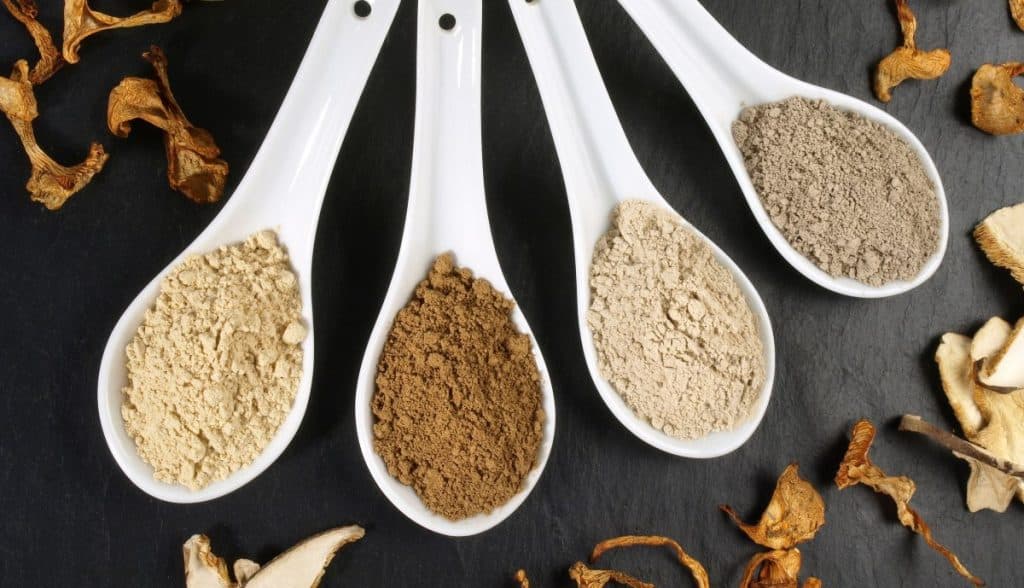
Dried Mushroom Powder vs. Mushroom Extract Powder
Two types of mushroom powder are available, and understanding the difference between them will help you choose the best one for your needs.
Dried Mushroom Powder
The first type of mushroom powder is dried mushroom powder. This type of mushroom powder is just what it sounds like and consists of ground-up dried mushrooms.
To make dried mushroom powder, culinary or medicinal mushrooms are dried and then ground into a fine powder. Some producers also make dried mushroom powder using mushroom mycelium or a mix of mycelium and fruiting bodies.
Dried mushroom powder contains all the nutrients found in fresh mushrooms and provides the same benefits as eating fresh mushrooms but in higher concentrations.
Dried mushroom powder is best used for culinary applications and will give your sauces, soups and stews a delicious burst of umami flavor.
If you plan on using mushroom powder mainly for medicinal reasons, then mushroom extract powder is the way to go.
Mushroom Extract Powder
Mushroom extract powder is more potent than dried mushroom powder because of how it’s made.
Instead of grinding up the dried mushrooms, producers use hot water extraction, alcohol extraction or both to extract beneficial compounds from the mushrooms.
A mushroom’s cell walls consist of chitin, a tough, fibrous substance made up of several polysaccharides that provide significant health benefits for humans.
In order to release the polysaccharides from the indigestible chitin cell walls, you need heat extraction. This process breaks down the chitin and makes the beneficial compounds more readily available.
After extraction, you’re left with a concentrated liquid extract containing loads of the mushrooms’ active compounds in a form that’s easier for humans to digest.
This concentrated liquid extract is then dried and powdered to create mushroom extract powder.
Large-scale producers use several different drying methods, including freeze and spray drying.
Different Ways to Use Mushroom Powder
Now that you have a better understanding of the different types of mushroom powder, you may be wondering how to use it.
But before we get into how to use mushroom powder, let’s look at some frequently asked questions on the subject.
What should you mix mushroom powder with?
Mushroom powder is incredibly versatile, and you can mix it with most ingredients and foods, both savory and sweet.
Some mushroom powders, usually those made from darker mushrooms, have more flavor than others, and their umami components enhance the flavor of cooked or baked dishes.
Other mushroom powders, like white mushroom or lion’s mane powder, have mild, subtle flavors that combine well with sweet foods like desserts, smoothies and shakes.
Does heat destroy mushroom powder?
No, heat does not destroy mushroom powder, as many of the mushroom’s beneficial compounds are heat-stable.
In fact, heat can enhance the bioavailability of important mushroom compounds, which is why producers use hot water extraction to make medicinal mushroom powders.
However, too much heat may affect some of the nutrients in mushrooms.
Temperatures of around 160°F (71°C) are considered ideal for preserving beneficial mushroom compounds while still making them easy for your digestive system to absorb.
Here are some easy ways to include mushroom powder in your daily routine:
1. Add Mushroom Powder to Coffee
Your morning cup of coffee may be the ideal way to take your daily dose of mushroom powder, and mushroom-enhanced coffee blends are growing in popularity.
Mushroom powders have a slightly earthy taste that pairs well with coffee and chocolate, and if you don’t enjoy the earthiness, try adding a touch of sweetener or your favorite creamer.
To make mushroom coffee, start by brewing your coffee as usual. When ready, add a teaspoon of mushroom powder and stir or whisk well to combine.
Add sweetener or creamer if desired, and enjoy.
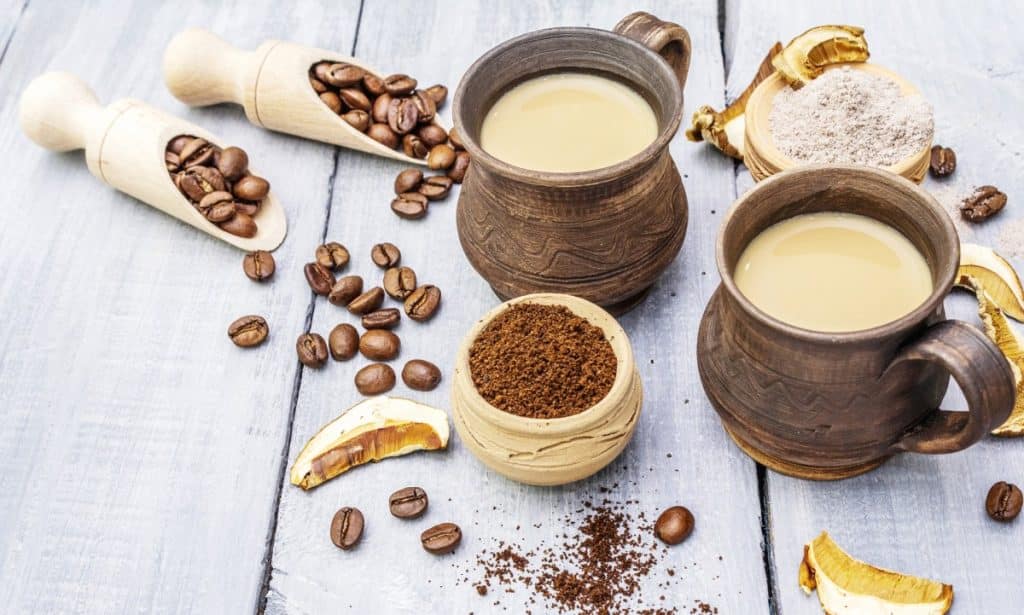
2. Make Mushroom Powder Tea
For many people, making and drinking tea is a relaxing daily ritual, and many cultures have traditions around brewing and using tea.
Like coffee, tea is the ideal way to consume mushroom powder, and traditional healers have used medicinal mushroom teas for thousands of years to treat numerous ailments.
To make mushroom tea, prepare your tea as usual and then stir in a teaspoon of your favorite mushroom powder.
Some people recommend adding medicinal mushroom powders to a calming tea just before bedtime to help improve the quality of your sleep.
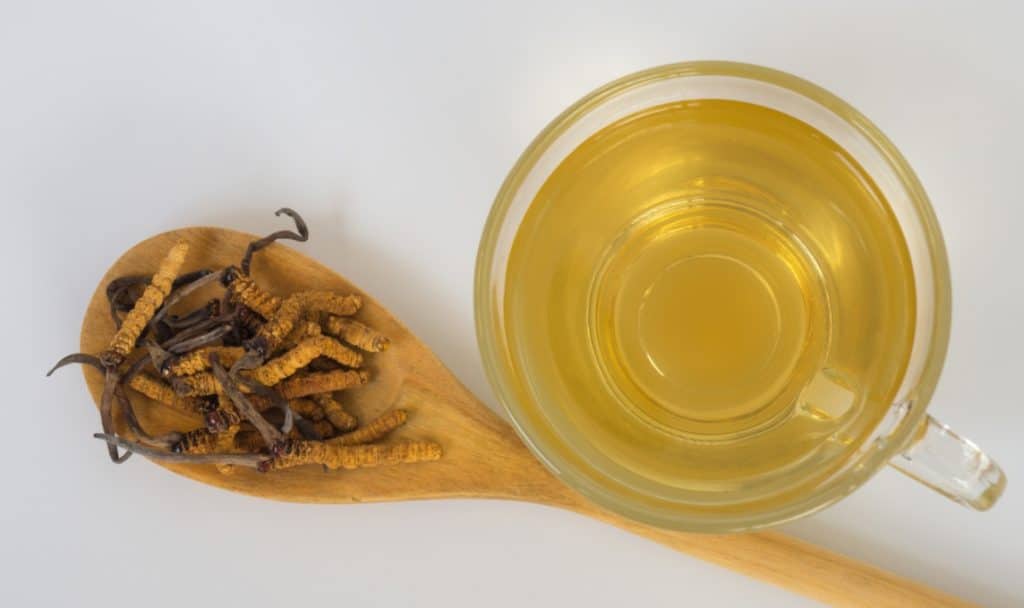
3. Mix Mushroom Powder into Smoothies, Shakes and Juices
Hot drinks aren’t the only way to use mushroom powder in beverages. You can add mushroom powder to your morning smoothie, protein shake or veggie juice for an extra nutritional boost.
Like coffee and tea, these beverages allow for relatively accurate dosing as long as you finish your drink.
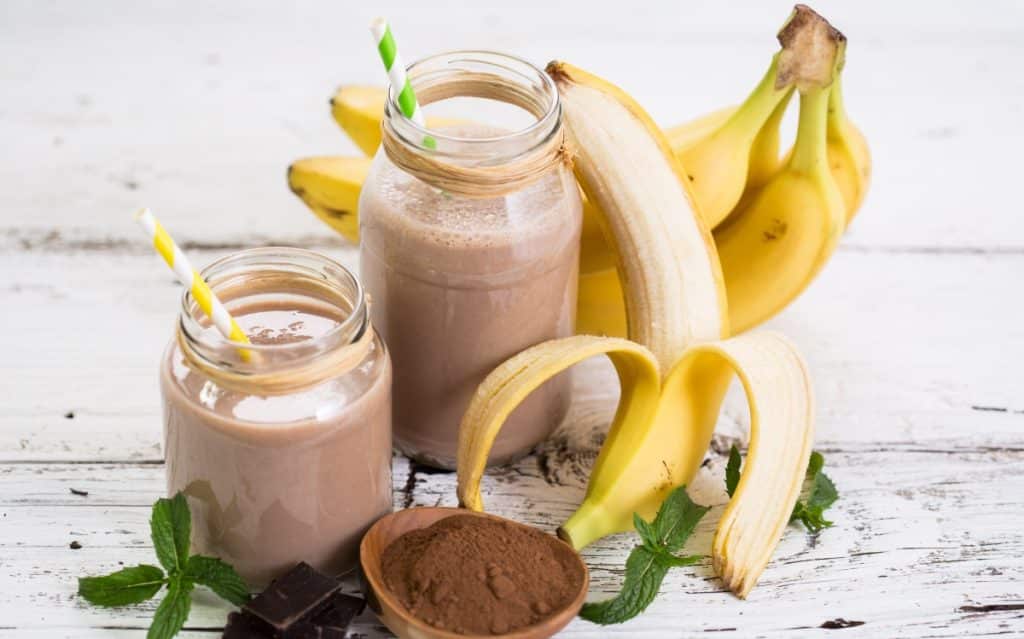
4. Add Mushroom Powder to Salad Dressings and Dips
Mushroom powders will give your salad dressing and dips a burst of flavor and boost their nutritional value.
This is a great way to add beneficial nutrients to your diet. But not the best way to consume specific doses of medicinal mushroom powders.
Unless you plan on consuming all the salad dressing or dip yourself, it’s impossible to know how much mushroom powder you’re getting.
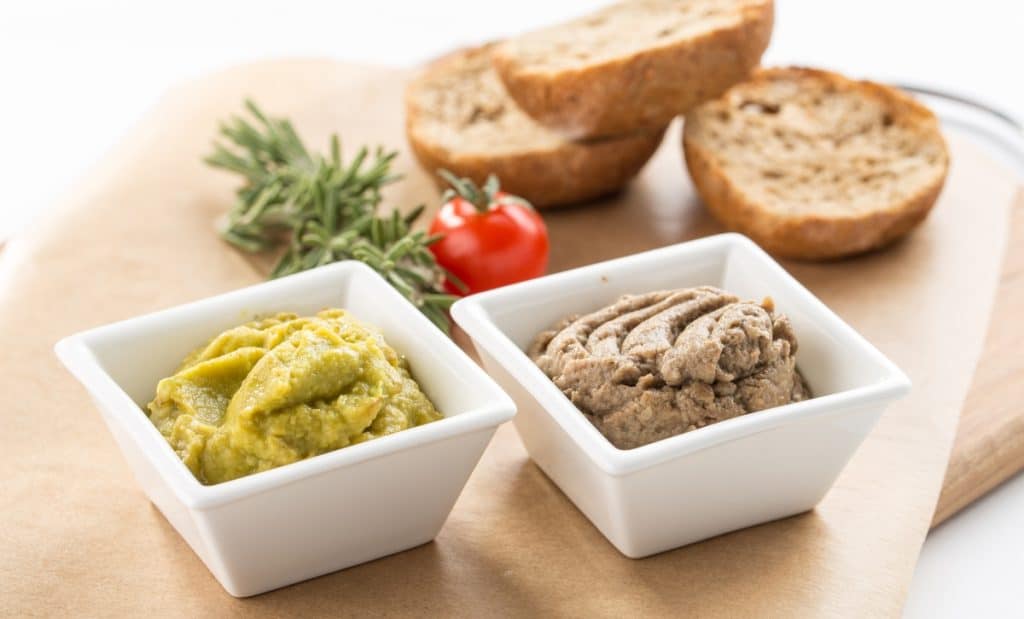
5. Sprinkle Mushroom Powder Over Oatmeal or Granola
If you’re a coffee or tea connoisseur and don’t want to modify the taste of your favorite morning beverage, try adding a teaspoon of mushroom powder to your breakfast.
Whether it’s piping hot oatmeal or a granola mix with fruit and yogurt, your mushroom powder will blend right in, especially mild-tasting powders like lion’s mane.
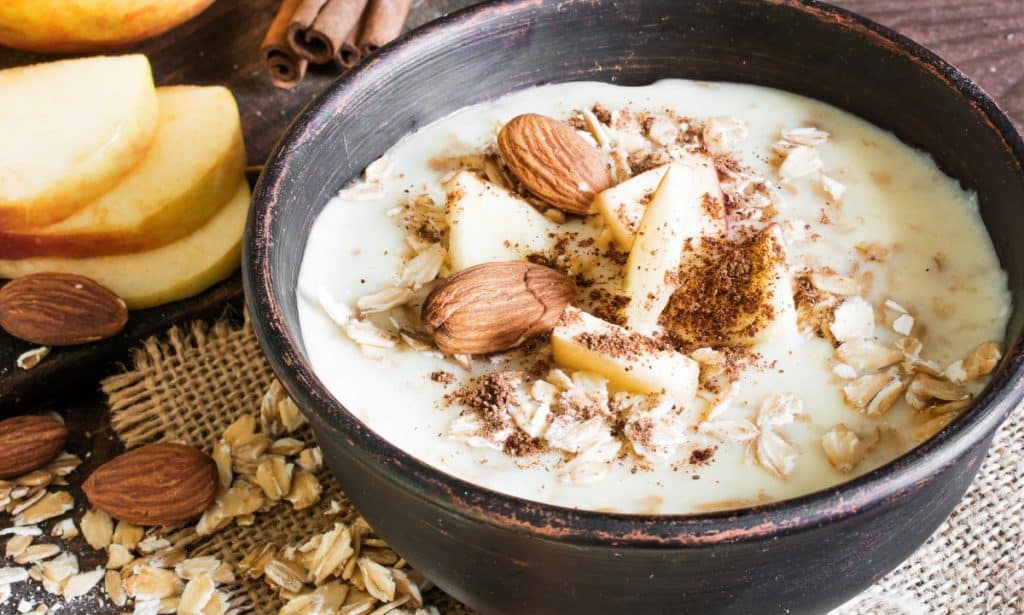
6. Use Mushroom Powder When Cooking
Adding mushroom powder to ingredients while cooking or baking is an easy way to increase the nutrient profile of any dish with very little effort.
In the section below, we look at some of the ways you can use mushroom powder while cooking.
7. Add Mushroom Powder to DIY Skincare Products
Several medicinal mushroom powders have soothing, skin-nourishing properties, making them a great addition to topical serums, lotions, creams, salves and face masks.
Here are a few of the mushroom powders that provide skin benefits:
- Reishi – Reishi mushrooms help the skin retain moisture, soothes and plumps dry skin, promotes circulation and helps to heal wounds, bites and stings.
- Shiitake – Shiitake mushrooms contain kojic acid that helps even skin tone and reduces dark spots.
- Chaga – The antioxidants in chaga mushrooms help to protect the skin from UV damage and combat the effects of oxidative stress, firming skin and reducing wrinkles.
- Cordyceps – Cordyceps is another medicinal mushroom with loads of antioxidants that help soothe inflamed skin and protect the skin from environmental damage.
- Maitake – Maitake mushrooms’ antioxidants, vitamins and minerals promote skin elasticity, boost collagen production and reduce redness.
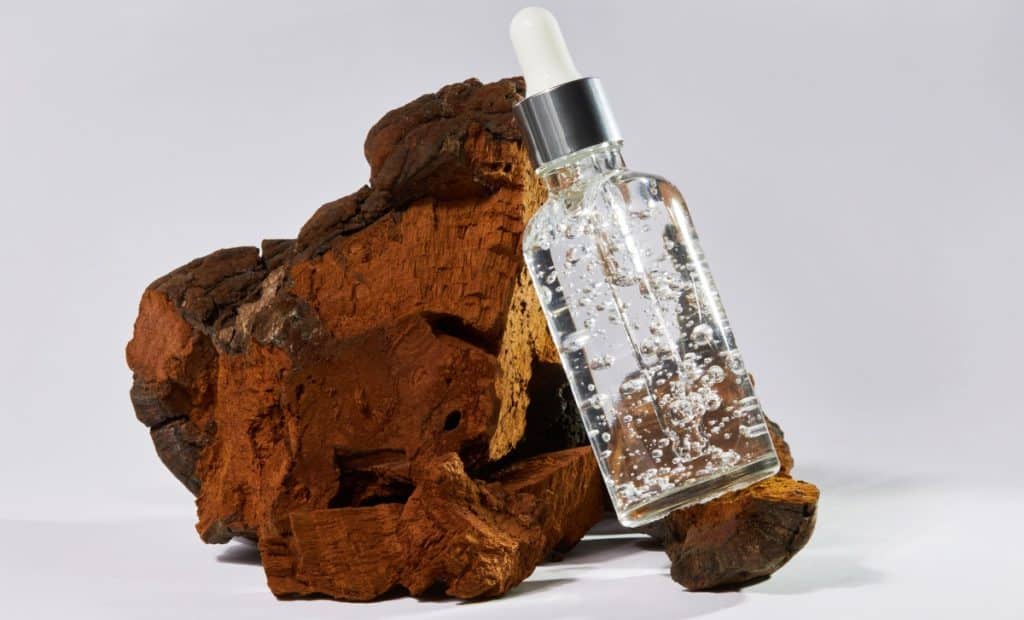
How to Use Mushroom Powder in Cooking
There are so many applications for mushroom powder when cooking. In fact, the options are almost endless.
Mushroom powders have stronger, more intense flavors than fresh mushrooms, so you won’t need much mushroom powder when substituting for fresh mushrooms in your favorite recipe.
People often recommend adding one teaspoon of mushroom powder per cup of fresh mushrooms. But no two mushroom powders are the same, so experiment with quantities until you’re happy with the result.
You can also add mushroom powder to recipes that don’t call for mushrooms, as their earthy umami taste is a great flavor enhancer.
Here are some ideas for using mushroom powder in your daily meals:
- Add to scrambled eggs and sauteed vegetables.
- Sprinkle over vegetables before roasting them.
- Add to broths, soups, stews, sauces, casseroles and curries.
- Use as a dry rub for fish, poultry or meat.
- Use as a seasoning for roast potatoes.
- Add a teaspoon to dry ingredients when making baked goods.
- Add to ground meat for meatloaf or hamburger patties.
- Use in a seasoning mix with salt.
- Make mushroom powder protein or energy snack bars.
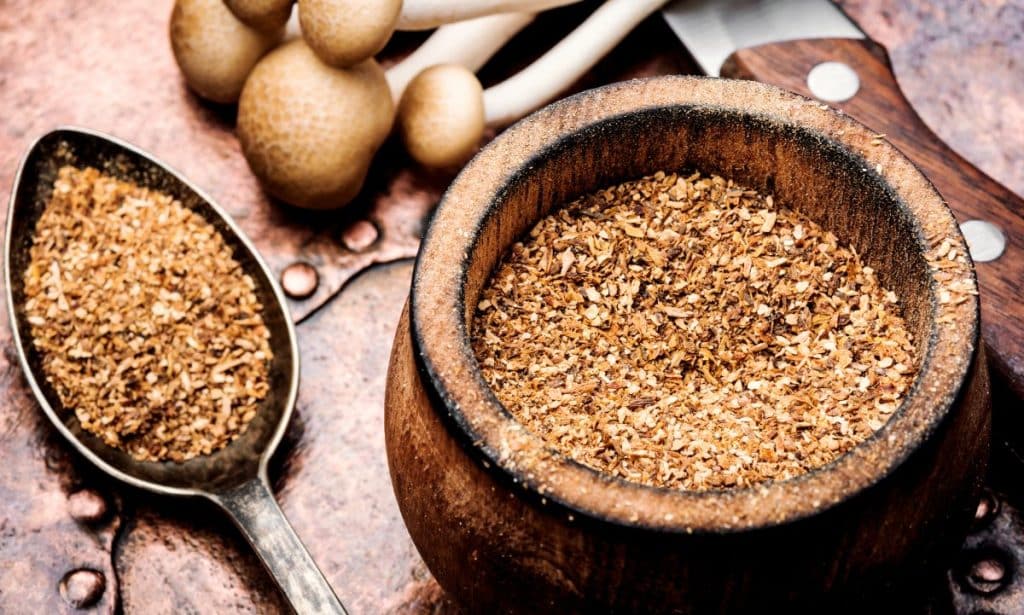
How to Use Medicinal Mushroom Powder
Like culinary mushroom powder, you can add medicinal mushroom powder to hot and cold beverages or meals.
But to ensure you get the correct dose, it’s best to add a teaspoonful to drinks or meals that you’ll finish yourself in one go.
Adding medicinal mushroom powder to tea, coffee or smoothies or sprinkling it over your morning oatmeal or omelet all work well.
However, using medicinal mushroom powder in sauces, stews or when baking will not allow you to keep track of how much you’ve consumed.
You can also get medicinal mushroom powder in capsule form. This allows for precise dosing and is very convenient for busy people and those who do not like the taste of mushroom powder.
How much mushroom powder should I take daily?
There is no set dosage for mushroom powders, but producers generally recommend 1 teaspoon (2 grams) of high-quality medicinal mushroom extract powder daily.
But every powder is different, and if in doubt, we recommend following the dosage instructions on the mushroom powder you have purchased.
When trying a new mushroom powder for the first time, start with a smaller dose, and if there are no side effects, work your way up to the recommended dose.
Does mushroom powder really work?
Traditional healers have used medicinal mushroom powders to treat various ailments for thousands of years with great success.
To understand how they function, scientists have tested mushroom extracts on animals and in test tubes, and the results of these studies have highlighted their potential health benefits.
Many products claim to offer specific benefits, but without clinical human studies, it’s difficult to separate fact from fiction.
However, due to the increase in popularity of medicinal mushrooms, mushroom research is increasing, and human studies are confirming their therapeutic potential.
We recommend trying mushroom extract powder for a few months to see for yourself.
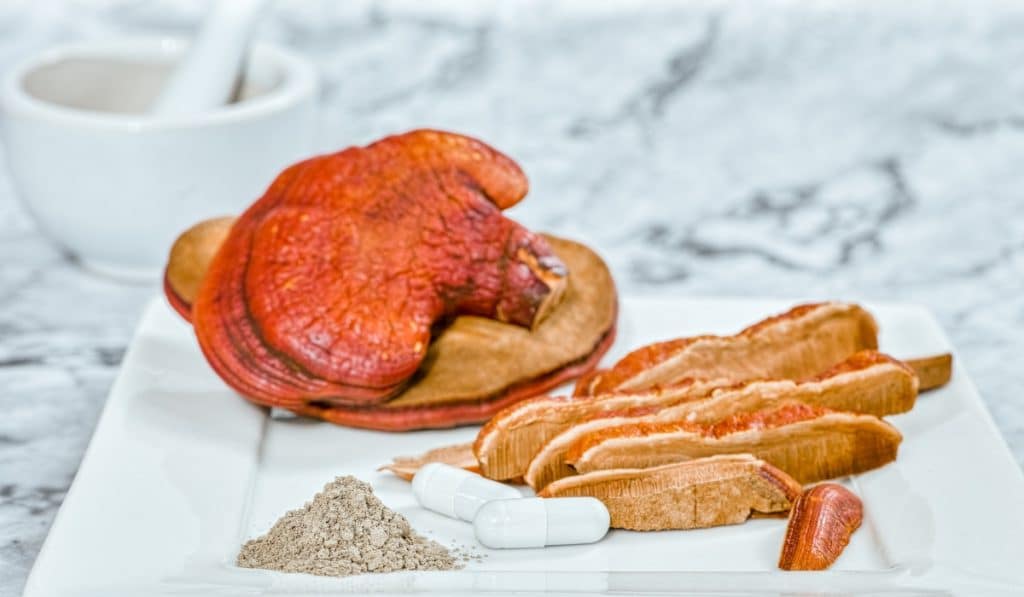
Mushroom Powder Benefits
In this post, we’re not going to look at the health benefits of mushroom powders but rather the benefits of using mushroom powder vs eating fresh mushrooms.
If you want to learn more about the health benefits of mushroom powder, visit our Mushroom Education Hub, where we have in-depth, research-based articles on the health benefits of several medicinal mushrooms.
Here are some of the benefits of mushroom powder vs fresh mushrooms:
Different Texture
If, like us, you enjoy the taste and texture of gourmet mushrooms, eating them regularly will take your meals to the next level and benefit your health.
However, not everyone is a fan of the texture of fresh mushrooms, and mushroom powder allows these people to enjoy their flavor-enhancing properties and health benefits without the texture.
Concentrated Flavor and Nutrients
When you dry mushrooms, they shrink in size, and their flavors and beneficial compounds become very concentrated.
A teaspoon of mushroom powder can be the equivalent of a cup of fresh mushrooms, meaning you need less to enjoy the same benefits.
Convenience
Mushroom powder provides a convenient way to enjoy a mushroom species flavor and health benefits. It only takes a few minutes to add a teaspoon to your tea, coffee, or smoothie or sprinkle it over a meal.
It’s also easier to transport mushroom powder than fresh mushrooms, and you can easily take it along on business trips or holidays.
Lasts Longer
Mushroom powder is easy to store, needs less space and lasts a lot longer than fresh mushrooms that you need to refrigerate and use within a few days of purchase.
It’s also a good idea to keep your mushroom powder in the fridge, but instead of lasting a week, it can last up to 2 years and still retain its potency.
For more information, have a look at our articles “How Long Do Mushrooms Last? Everything You Need To Know ” and “How to Store Mushrooms: The Best Methods to Keep Them Fresh.”
More Accurate Dosing
When you eat fresh mushrooms, it’s impossible to know how many of the mushrooms’ beneficial compounds you’re accessing.
But, if you buy a high-quality, laboratory-tested mushroom powder, you know what you’re getting, have more control over the daily dose and can easily adjust it to get the benefits you’re after.
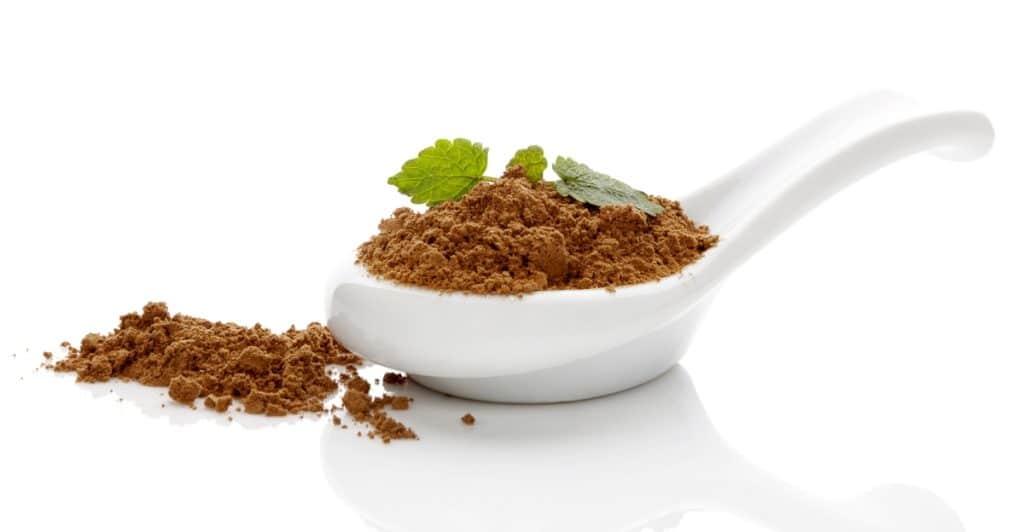
What to Look for When Buying Mushroom Powder
Deciding which mushroom powder to buy can be daunting.
However, if you know what to look for, a quick glance at the ingredients on the product label will tell you all you need to know and ensure you choose a high-quality product.
Here’s a short guide on what to look for when buying mushroom powder:
1. Fillers or Additives
Check the ingredients list on the label for any unnecessary fillers, binders or preservatives. The best mushroom powders contain 100% pure mushroom fruiting body extracts.
Unnecessary additives and fillers dilute the beneficial compounds, reducing the powder’s potency.
2. Extraction Method
When buying medicinal mushroom powder, ensure it is dried mushroom extract not just dried and powdered mushrooms.
The extraction method used to make it is also crucial, as it affects the concentration of beneficial compounds in the mushroom powder.
Look for medicinal mushroom powder made using the dual extraction method, i.e. both alcohol and hot water extraction, to get a broad spectrum of bioactive compounds.
3. Organically Sourced Mushrooms
Mushrooms absorb minerals and toxins from the substrate they grow in and the environment around them.
To ensure you’re getting a mushroom powder free of harmful pesticides, herbicides or chemicals, check to see that it’s made using organically certified mushrooms.
4. Concentration
As mushroom extract powders are more concentrated than dried, powdered mushrooms, it’s beneficial to check the concentration or extraction ratio of the product.
This gives you an idea of the potency of the mushroom extract powder per serving and helps with dosage.
For example, an extraction ratio of 12:1 would mean that 1 gram of mushroom extract powder is equivalent to 12 grams of dried fruiting body.
Another way to explain this is that the producers used 12 grams of dried mushrooms to make 1 gram of mushroom extract powder.
But although the extraction ratio gives you an idea of the strength of the powder, it’s not always a guarantee of quality, as all it tells you is how many mushrooms the producers used to make the extract.
The quality of the mushrooms and the extraction method play a much more important role in making high-quality mushroom powder.
However, knowing the extraction ratio is beneficial when buying organic mushroom powder from a reputable supplier.
5. Beta Glucans Content
Beta-glucans are the compounds in mushrooms that are responsible for many of the health benefits.
So, rather than worrying too much about the extraction ratio, check the label to see if the producers list the concentration of beta-glucans and other beneficial compounds in the powder.
The higher the beta-glucans, the better.
6. Third-Party Testing
One way to ensure you are getting a mushroom powder that lives up to the claims made on the label is to buy mushroom powder that has undergone third-party testing.
This will confirm that the powder is free from contaminants or fillers and provides the dosage claimed on the label.
Final Thoughts
Whether you want to boost the flavor of your meals or your immune system, mushroom powder is a convenient option.
But as there are so many mushroom powders on the market, many with inflated health claims, it can be confusing.
We recommend buying your mushroom powder from a reputable supplier that only uses sustainably sourced, organic fruiting bodies when making the powder.
And, if possible, support local mushroom farmers and producers as this supports local business and reduces the transport required to get the product to you.
You could also grow delicious gourmet mushrooms at home and make your own culinary or medicinal mushroom powder. It’s a great way to use tough mushroom stems that you may not want to cook or preserve excess fresh mushrooms.
To learn more about growing mushrooms at home, visit our Mushroom Growing Hub or enroll in one of our mushroom cultivation courses.
